Festival Review: Ten Highlights from Big Ears 2025
By Noah Schaffer
Despite — or maybe because of — all the global turmoil, an awful lot of compelling music was heard at Big Ears.
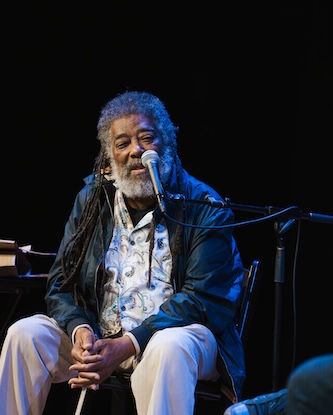
Composer/Trumpeter Wadada Leo Smith at Big Ears. Photo: J Hubbard
In some ways this year’s edition of Big Ears was business as usual. The Knoxville festival’s 12th edition yet again presented at least 200 music performances, film screenings, panels, and other events, encouraging a four-day immersion into cutting edge creativity. Knoxville’s venues, restaurants, and residents all shined as they welcomed in the thousands of attendees who had purchased every available ticket well in advance of the festival. So did the Knoxville Symphony Orchestra, as it deftly performed a new arrangement by Boston’s Edmar Colón of “Rhapsody in Blue” with classical pianist Lara Downes, jazz saxophonist Greg Tardy, and bluegrass mandolinist Wyatt Ellis before conductor Aram Demirjian provided a model of how to make challenging new music understandable as he briefly introduced Tyshawn Sorey’s Pulitzer-winning “Adagio (for Wadada Leo Smith).”
But, of course, there is no such thing as business as usual these days, especially when it comes to the arts. Especially the kind of creativity that Big Ears showcases: artists from a wide variety of backgrounds who, while acclaimed in their field, usually work well outside the borders of the mainstream music industry. Festival artistic director Ashley Capps has described the event as a series of “cultural conversations.” Right now, those discussions include the future of arts funding and access amid ongoing attempts at silencing cultural voices.
The response from the participants and audiences was almost as wide-ranging as the music. Many let the music speak for itself. Pianist Sylvie Courvoisier, for example, after starting with a piece that evoked the sounds of nature, read aloud from a list of words that had been recently scrubbed from government websites. When the music resumed, the electronics of Ikue Mori sounded with the explosion of an alarm. Another artist who evoked natural sounds, Afrocentric percussionist and Ethnic Heritage Ensemble founder Kahil El’Zabar, simply explained that his musical practice of more than 50 years was now needed “more than ever.”
One major creative music figure even asked that no one record a portion of their panel discussion — “I’ve already been targeted,” they said, which isn’t surprising, given that the artist also teaches at an academic institution whose federal funding is being threatened. For Ukraine’s DakhaBrakha, American politics is a matter of life, death, and sovereignty. And then there were Irish folk mavericks Lankum, who updated the traditional “The Rocks of Bawn” into a song about the plight of Palestinians, and followed it with “Peat Bog Soldiers,” a song written in a Nazi concentration camp.
Despite — or maybe because of — all the global turmoil, an awful lot of compelling music was heard. With 14 concurrent venues, no one could hear all or even most of it — even if, like me, you started your day with a 9 a.m. film and ended it after 1 a.m. with the collective noise of Water Damage. (That day my phone counted 10 miles of walking between the venues.) I tended to prioritize full sets over trying to sample everything and I focused on acts I don’t normally get to see in Boston. The 30 minutes I caught of Joe Lovano’s new Paramount Quartet with Julian Lage, Asante Santi Debriano and Will Calhoun made me eager to take in their entire show when they play the Somerville Theatre on April 13.
Here were some of my favorite moments in chronological order:
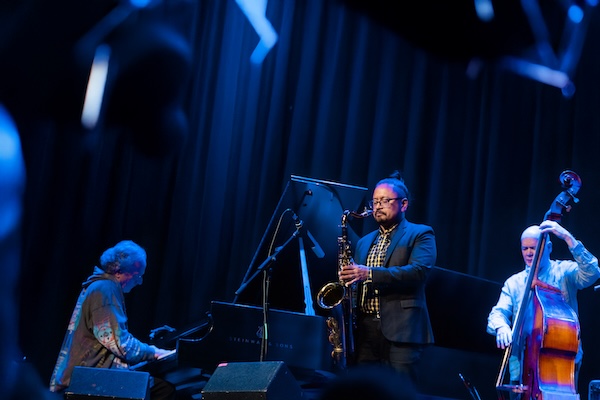
A look at Axiom Five. Photo: Cora Wagoner
Axiom Five – Despite playing a key role in the development of free jazz drumming, Barry Altschul claims that his career was at a low point until about a decade ago when, after he teamed up with saxophonist Jon Irabagon, the world learned that Altschul was still making music. Their creative partnership has blossomed into a series of recordings and tours. The pair appeared at Big Ears, playing with Axiom Five and 3 Dom Factor. Because trombonist Ray Anderson was unable to join them, the Axiom group was a quartet that also included pianist Uri Caine and bassist Mark Helias. Their fully improvised set showcased what Altschul, in an interview the next morning with author Ashley Khan, called his “freebop style.” In that illuminating (and under-attended) conversation, Altschul talked about how his generation of drummers was interested in swinging, no matter how “free” the music became, in contrast to today’s “groovers.” Altschul’s approach was obvious when he and his formidable peers let loose with their versions of tension and release.
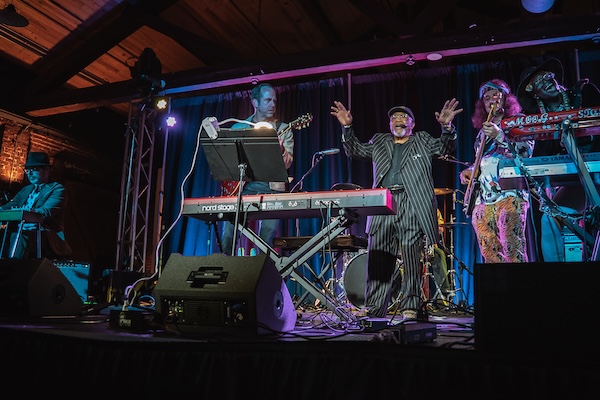
Swamp Dogg in action. Photo: Ash Ogle
Swamp Dogg – The iconoclastic soul singer/songwriter/producer Jerry “Swamp Dogg” Williams has had a very big 82nd year. His album Blackgrass: From West Virginia to 125th Street, recorded with a host of super-pickers, ended up on plenty of “best of” lists, as did the documentary Swamp Dogg Gets His Pool Painted, which was screened at the festival. (The film is slated for theatrical distribution and streaming in the coming months.) In a set that mixed his new material with his classics. Swamp Dogg’s deep soul vocals, strong as ever, were matched by a band that included his longtime keyboardist cohort Moogstar and a pedal steel player. After “Total Destruction to Your Mind” was finished, a familiar voice in the audience repeated the title: it was Lonnie Holley, the great outsider artist who himself appeared on three different sets over the weekend. Swamp Dogg is slated to play the FreshGrass Festival in North Adams, Massachusetts, this fall. Another great R&B moment came when seminal indie rock band Yo La Tengo and the Sun Ra Arkestra played a collaborative set. Besides serving up the expected outer space jazz, the band revived the gorgeous harmonies of “Dreaming,” a melancholy mid-’50s doo-wop song that Ra had recorded with Cosmic Rays.
ANOHNI and the Johnsons – ANOHNI possesses one of the greatest and most distinctive voices in modern pop music. She’s recently resumed touring and recording with her chamber pop ensemble, the Johnsons, after a decade and a half hiatus. Not surprisingly, the trans torch singer had plenty to say both in and between her songs about the current political repression in America and the ecological state of the world. But her brilliantly theatrical performance also paid tribute to her inspirations: Little Jimmy Scott on “Sometimes I Feel Like a Motherless Child,” Lou Reed and the Velvet Underground with “Coney Island Baby” and “”I’m Set Free,” and, most interestingly, the disgraced Buffy Sainte-Marie’s “Little Wheel Spin and Spin.”
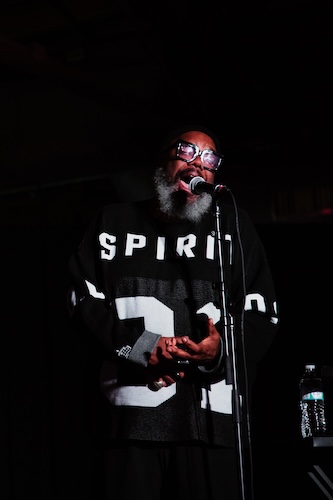
Kokayi in action. Photo: Ashli Linkous
Kokayi – For those like me, who are just discovering the pulsating ideas and rhymes of this exceptionally versatile Washington, DC, singer and MC, it appears that he’s been hiding in plain sight. He wrote a 2022 book and has a long history of adding his improvised lyrics to both hip-hop and jazz projects, including Ambrose Akinmusire’s new Honey from a Winter Stone. Performing with his funky quartet, Kokayi paid tribute to go-go music and sang his soul music anthems about living in these times.
Joe Boyd’s “And the Roots of Rhythm Remain” – Far more than a series of concerts, Big Ears featured nearly 50 interview/panel discussions and film screenings. Famed producer Joe Boyd curated a series of films and also put together a two-hour multimedia version of his new book And the Roots of Rhythm Remain. Drawing on film and audio clips, he touched on a range of topics, from how differing policies toward slaves resulted in the development of different musical styles throughout the Americas to the birth of Afro-Cuban jazz and the roots of the Roma tradition in India. Even if the specific segments of musical history were familiar, the way Boyd linked all of them together was fascinating.
Wadada Leo Smith and Vijay Iyer – This was a very good year for octogenarians at Big Ears. In addition to the previously mentioned Altschul, Boyd, and Swamp Dogg, Michael Hurley (who recently passed away) performed a lineup of his quirky and charming folk songs.Taj Mahal’s set list has not changed much, but the addition of band members playing steel pan and Hawaiian lap steel guitar infused the bluesman’s sound with some new colors. Busiest of all was Wadada Leo Smith, the composer/trumpeter who was in residence throughout the weekend, playing his music with five different ensembles as well as in Courvoisier’s group. Smith’s duet with pianist Vijay Iyer was a masterclass in the use of space and silence. Just as great was his Radio Light group, which included the thrill of a drum duet between two other legends: 85-year-old Andrew Cyrille and longtime Bostonian Ra Kalam Bob Moses.
Across the Horizon – Another Big Ears tradition is tossing more than one “festival within a festival.” One of those this year was a gathering that focused on the wide swath of sounds that fall under the umbrella of ambient country music. One of the pioneering artists in that scene is the band SUSS — member Bob Holmes also hosts the Ambient Country podcast. On two late nights inside the beautiful Point church sanctuary, SUSS hosted all-star ambient country revues. The portion I caught included a duet between harpist Mary Lattimore and guitarist William Tyler, a short story read by author Geoff Dyer with SUSS providing live accompaniment, and, best of all, the music of Nanocluster, who combined the cinematic dreamscapes of SUSS with the dance beats of the Wire-spinoff electronic duo, Immersion. Nanocluster are on a short tour, which will come to Boston’s Cafe 939 at Berklee on April 3.
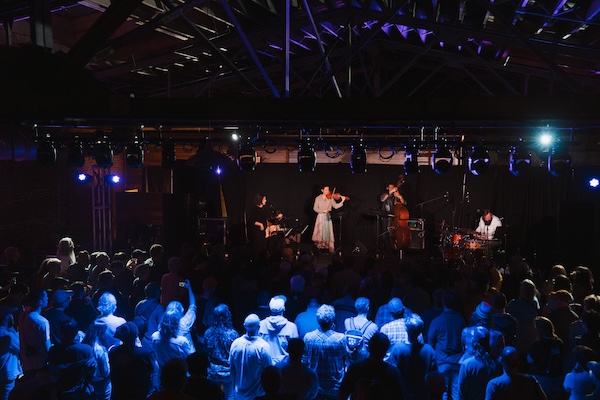
The Susan Alcorn Tribute at Big Ears. Photo: J Hubbard
Susan Alcorn Tribute – Sadly, two of the artists scheduled to appear at Big Ears passed away before the festival took place. Tabla legend Zakir Hussain’s colleagues Charles Lloyd and Eric Harland were joined by several guests, including guitarist Bill Frisell and Harvard graduate ganavya. They didn’t try to replace Hussain with another tabla player; neither was there a pedal steel on stage during a performance of an ensemble that the late Susan Alcorn had convened to play her music. Drummer Ryan Sawyer explained that this meant the group had to essentially write Alcorn’s parts out of her own music when they rearranged her compositions. The set proved that, besides being one of the most original voices on the pedal steel, Alcorn was also a magnificent composer. I’m not sure I’ve ever heard guitarist and Big Ears regular Mary Halvorson play so emotionally.
Magic Tuber String Band – Because it is a festival that takes place in Appalachia, Big Ears inevitably features artists who experiment with folk and bluegrass sounds, as well as the Celtic styles that helped to give birth to American string band music. Along with Lankum, the Celtic world was well represented by the extraordinary Scottish smallpipes musician Brìghde Chaimbeul. She was joined by frequent Big Ears presence Shahzad Ismaily, whose keyboard parts added even more drone to the proceedings. Both Celtic and Appalachian sounds were turned upside down by the Magic Tuber String Band. As the trio switched between fiddles, banjo, guitar, and bass you could hear traces of everything from minimalism to Hindustani slide guitar in the virtuosic and hypnotic but never showy sound.
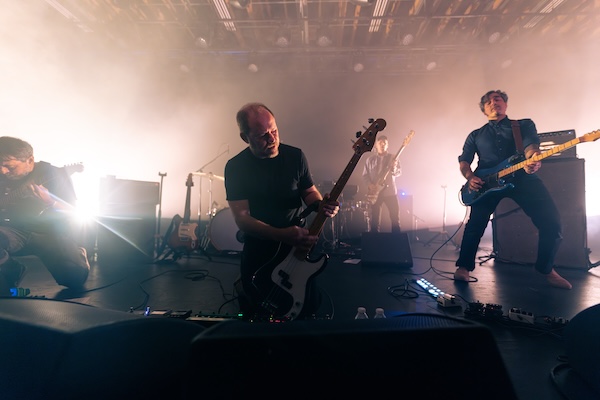
Explosions in the Sky winding up Big Ears. Photo: Eli Johnson
Explosions in the Sky – After four days of highly cerebral music it was time for a cathartic finale. That role was perfectly filled by the long-running Texas indie rock instrumental band Explosions in the Sky. Almost completely obscured by red light and stage fog, they offered endless dynamics before supplying a climactic finish.
Given there was much on offer, not everything was for everyone. The ecstatic audiences that wanted to see the British “out” jazz quartet Ahmed greatly exceeded the venue’s capacity both times. I was glad to be given the opportunity to see the veteran pianist Pat Thomas and his quartet, Joel Grip (bass), Antonin Gerbal (drums), and Seymour Wright (saxophone), but their sound struck me as being more energetic than original. But my disappointment didn’t last long. As soon as they were finished, there were four more places that I wanted to be at once.
Noah Schaffer is a Boston-based journalist and the co-author of gospel singer Spencer Taylor Jr.’s autobiography A General Becomes a Legend. He also is a correspondent for the Boston Globe, and spent two decades as a reporter and editor at Massachusetts Lawyers Weekly and Worcester Magazine. He has produced a trio of documentaries for public radio’s Afropop Worldwide, and was the researcher and liner notes writer for Take Us Home – Boston Roots Reggae from 1979 to 1988. He is a two-time Boston Music Award nominee in the music journalism category. In 2022 he co-produced and wrote the liner notes for The Skippy White Story: Boston Soul 1961-1967, which was named one of the top boxed sets of the year by The New York Times.
